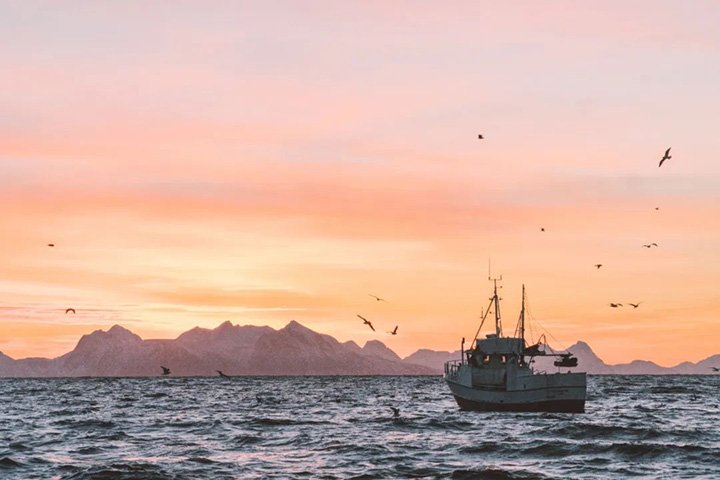 @Knut Troim on Unsplash
@Knut Troim on Unsplash
2022年,农业农村部发布了《“十四五”全国渔业发展规划》、《关于加强水生生物资源养护的指导意见》等政策文件,提出以高质量发展为主要目标,根据我国渔业发展和管理实际,借鉴国际管理经验,进一步完善休禁渔、限额捕捞、总量管理等制度,建立养护与利用结合、投入和产出并重的管理机制,推进渔船渔港管理制度改革,加强执法监管。
为助力推动我国可持续渔业的发展,NRDC根据公开资料梳理了重点渔业国家和地区2022年相关政策方面的进展,供决策部门参考。总体来看,各国都在推进可持续渔业的发展,加强与打击非法、不报告和不受管制(IUU)捕捞相关的监测、执法和可追溯制度,扩展和完善限额捕捞(TAC)管理,并在坚持渔业生态可持续原则基础上增加对社会和经济维度、管理效率以及应对气候变化等元素的考虑。
欧洲
ꔷ 欧盟
6月,欧盟委员会发布《欧盟迈向更可持续的渔业:现状和2023年方向》。据报告称,2020年欧盟水域的渔业种群状态总体在改善,东北大西洋首次实现了最大可持续产出(MSY)水平上的可持续捕捞,地中海区域的捕捞死亡率降到2003年以来最低,但波罗的海的渔业种群状态因为历史性过度捕捞和环境问题出现了倒退。在船队方面,截至2021年底,欧盟注册船只的数量、吨位和马力分别为74380艘,1,320,362公吨和5,304,015千瓦,但成员国上报的功率数据的可信度遭受了质疑。油价成为船队盈利的最大挑战:油价自2022年3月以来大幅上涨,拖网渔船等高度依赖燃油的船队受油价上涨的负面影响最大。2023年,欧盟的工作重点包括:继续改善地中海的渔业管理,推进上岸义务的履行和执法,以及更好地收集数据等。
9月,欧盟审计局(ECA)发布《专题报告20/2022: 欧盟打击非法渔业的行动》。报告回顾了2014年-2020年欧盟在打击IUU捕捞活动方面形成的政策框架、具体行动和经费支出,重点评估了成员国对本国船只的监管和防止进口非法海产品这两个体系的有效性。欧盟于此期间在监测、控制和监督(MCS)方面投入了5.8亿欧元的资金,总体上减少了IUU捕捞风险,但有关措施的实施效果因成员国参差不齐的表现打了折扣。一些成员国的监管存在重大漏洞,或处罚金额与违法行为不相称等问题,都加剧了过度捕捞和捕捞量少报。不同成员国检查执法的差异还损害了欧盟用来管控进口海产品的渔获物合法性证明制度。报告建议,欧盟应监督并促使成员国实施更有威慑力的处罚措施,并通过强制使用电子化的可追溯体系来有效降低IUU捕捞风险。
 欧盟执法资源分配情况 @欧盟审计局
欧盟执法资源分配情况 @欧盟审计局
ꔷ 西班牙(欧盟成员国)
12月,西班牙《可持续渔业和渔业研究法草案》获得内阁的批准,正在等待议会的最后批准。该法案将对2001年生效的《西班牙国家海洋渔业法》进行修订,在欧盟以及其他国家和地区20年来在海洋渔业政策上取得的进展基础之上,进一步加强西班牙渔业的可持续性原则(包括经济、社会和环境三个维度)。重点内容包括:建立全新的配额分配标准,对捕捞配额或捕捞努力量的转让机制进行更新,以及加强科学对政策的支撑等。
ꔷ 挪威
7月,挪威对长度在11米以上的渔船全面实施电子报告系统(ERS)。为更加有效地监督、控制捕捞活动以及统计和研究渔获物情况,挪威在2009年制定了《挪威渔船位置报告和电子报告条例》,并推动分步骤落实电子报告系统。根据该条例,履行电子报告系统的义务包括进出港报告以及捕捞报告(至少每日一次),参与转运的船只还必须发送转运通报。15米以上的渔船已于2021年9月开始强制实施电子报告系统。
ꔷ 冰岛
10月,冰岛食品、农业和渔业部长启动了名为 “我们的资源” 的全面渔业政策改革。此次改革的目标是 “与环境和社会相和谐,更有效率和可持续地利用海洋资源”,重点工作包括解决渔业配额高度集中化和利润分配不合理导致的不公平问题。部长委派的专家组对管理现状与渔业权关系进行了梳理,并公布了提案初稿。60项提案分别服务三大目标:环境优先、价值最大化和公平分配。这项改革最终将推出全新的渔业或海洋资源法。
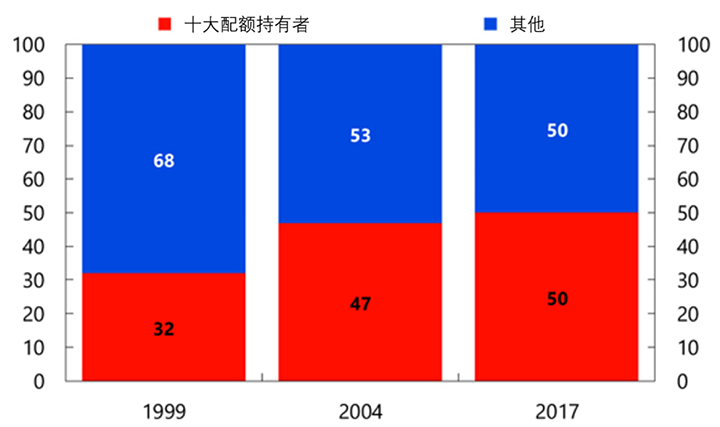 冰岛渔业配额日益集中于少数几个持有者① @冰岛渔业局
冰岛渔业配额日益集中于少数几个持有者① @冰岛渔业局
ꔷ 英国
11月,英国多个政府部门发布了“联合渔业声明”(JFS)。英国在“脱欧”后出台了40年来首部国家渔业法《2020年渔业法》,列出了以可持续发展为首的八项目标,并规定渔业部门通过制订“联合渔业声明”的方式来明确渔业管理的战略性方向以及实现八项目标的具体政策。其中,制订和实施分种群、分渔业类型和地理区域的渔业管理计划(FMPs)将成为英国实现可持续渔业的关键政策工具。
北美洲
ꔷ 加拿大
4月,加拿大《2019年渔业法》第十次修订生效。为进一步推动可持续渔业的发展,加拿大渔业和海洋部对该法进行了第十次修订,首次赋予种群重建法律约束力。新增条款规定,一旦主要种群的资源量低于极限参考点,加拿大渔业和海洋部部长必须在3年内为其制订种群重建计划。重建计划必须包含种群衰退原因、可衡量目标、重建时间线和执行方案等具体内容。首批适用该规定的主要渔业种群共30个, 其中16个种群需进行重建。
ꔷ 美国
3月,美国国家海洋渔业局(NOAA Fisheries)发布《种群状况年度报告》和《2020年美国渔业报告》。前一份报告显示,2021年,在460个已有数据的种群中,美国80%以上的种群未被过度捕捞,51个种群(比2020年增加两个)仍被过度捕捞。后一份报告显示,2020年,美国商业捕捞量达到84亿磅(约合380万吨),价值47亿美元。休闲钓鱼者捕捞了约10亿条鱼,并放归了其中65%的鱼。可能是受新冠疫情的影响,美国的鱼类上岸量下降了10%。
4月,美国国家海洋渔业局公布新的数据共享工具- 渔业分布地图与分析门户 (DisMAP),用于支持物种保护与管理决策。该工具将历史调查数据转换为可视化地图,可显示超过800种鱼类的分布区域及一些鱼类在不同季节分布区域的的变化。已有的数据显示,许多海洋物种因气候带来的海洋环境变化进行了迁移,而这些对渔业管理如配额的分配和禁渔区的设置都会带来显著影响。
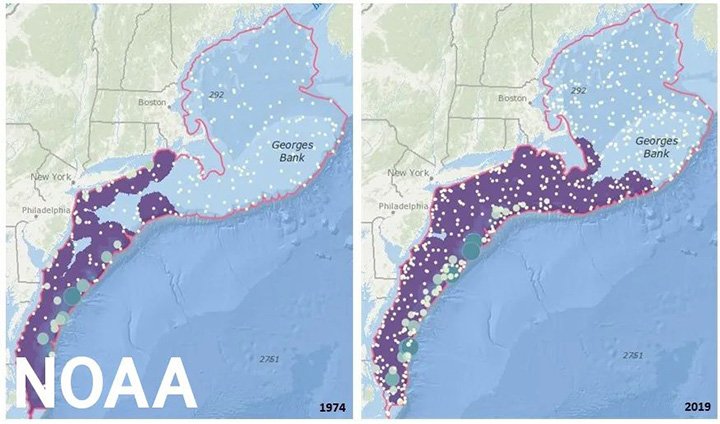 DisMAP显示因气候变化黑海鲈等物种明显向北迁移 @美国国家海洋渔业局
DisMAP显示因气候变化黑海鲈等物种明显向北迁移 @美国国家海洋渔业局
12月,美国国家海洋渔业局发布《渔业战略规划2022-2025》。规划明确了这一阶段的三大战略目标:1)适应性地管理渔业(尤其是应对气候变化)以实现可持续性和经济竞争力;2)受保护物种的恢复;以及3)促进公平和环境正义。每个目标还包括了具体的策略,例如可持续目标下包含了推动气候科学和基于生态系统的渔业管理、数据收集的现代化和打击IUU捕捞等策略。 12月,美国国家海洋渔业局公布了海产品进口监控计划(SIMP)扩充提案,征求公众意见。SIMP本质上是一种可追溯制度,规定了在进口某些IUU捕捞风险较高的鱼类和海产品时,美国进口商必须获得相关许可并报告和保管从捕捞点到进入美国全过程的数据,以避免IUU捕捞或假冒海产品进入美国市场。最新公布的提案将已有的13个类别约1100个鱼种扩充为18个类别1670个鱼种,新增种类包括章鱼、墨鱼、鱿鱼、鳗鱼等。
大洋洲
ꔷ 澳大利亚
4月,澳大利亚政府发布《2022-2030年国家渔业规划》,提出了该国捕捞业、养殖业和其他海产业的可持续增长目标,确定了九个优先领域,并拟定了2030年前各领域的具体目标和关键行动。例如,通过加强跨部门国家电子数据收集系统的建设等三项行动改善渔业治理;通过确保所有渔业按照 “生态可持续发展原则” 以及“最佳管理实践指南”进行管理等六项行动实现可持续和健康的渔业资源;通过加强海产品追溯体系等四项行动来有效打击IUU捕捞,同时提高澳大利亚海产品的国际市场竞争力,从而扩大出口规模。
6月,澳大利亚国家渔业合规委员会发布《2022-2026年渔业合规战略》。尽管澳大利亚渔业管理被认为是世界上最先进的体系之一,但在执法上仍然面临巨大的挑战,包括过度捕捞风险、有组织犯罪、越来越复杂的管理规定和有限的执法资源等。鉴于执法成本较高,澳大利亚将“最优合规水平”定为“在不损害渔业管理的完整性或生态可持续性前提下,违规问题处在可用合理的成本维持的、可接受的水平”,并制订了最大化自愿守法、有效的威慑以及加强组织和技术能力建设三大策略。
11月,澳大利亚政府发布《2022年渔业状况报告》。澳大利亚农业和资源经济与科学局(ABARES)从1992年开始每年发布报告,评估联邦政府单独管理或者联合管理的渔业种群的生物学状况和渔业经济状况。这部分渔业种群约占澳大利亚渔业总产量的38%,2021年总产值为3. 74亿美元。结果显示,渔业种群在2021年总体处于比较稳定的状态。101个被评估种群中,81个种群捕捞压力适当,69个种群资源量高于最大可持续产出(MSY)对应的水平,但资源量过低的种群与2020年相比增加了两个,达到13个。
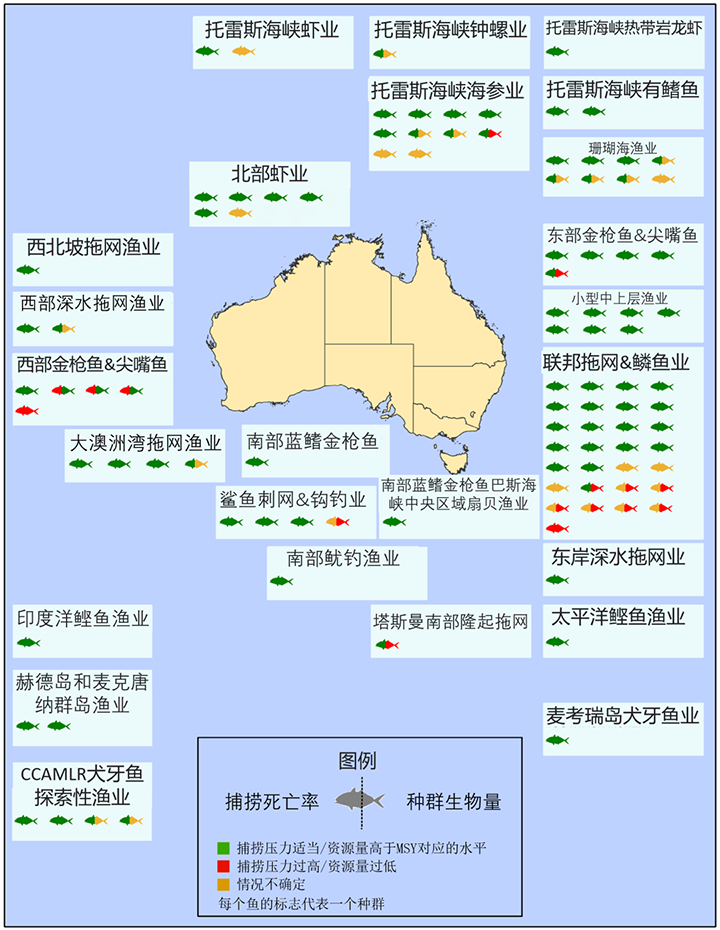 2021年由澳大利亚政府单独或联合管理的鱼类种群的生物学状况 @澳大利亚农业和资源经济与科学局
2021年由澳大利亚政府单独或联合管理的鱼类种群的生物学状况 @澳大利亚农业和资源经济与科学局
ꔷ 新西兰
11月,新西兰《渔业修订法案》生效。该法案对1996年《渔业法》进行了修订,包括简化但加强了配额管理鱼种的上岸和丢弃管理,以及创建了一个分级处罚体系。新的违规处罚体系即刻生效,而上岸和丢弃禁令有四年的过渡期。新西兰正在逐步推进“渔业改革计划”,目的是加强新西兰渔业管理并推动渔业管理的现代化,同时确保新西兰渔业的可持续性,实现经济、社会和文化价值。这一改革计划由三部分组成:1)引入强制性电子渔获物和船位报告以改善渔业数据的收集;2)制订简单、公平和负责任的渔业规则和政策;以及3)提升渔获物监测和核验能力。此次对《渔业法》修订就是渔业改革计划的内容之一。
亚洲
ꔷ 日本
3月,日本内阁批准了新的渔业基本计划(Fishery Basic Plan)。渔业基本计划根据日本《渔业基本法》制定,约五年修订一次,旨在全面、系统地指导渔业发展,涵盖渔业、养殖业和流通加工等产业。新的计划确立了未来十年的三大方向:1)稳步推行“新资源管理”②;2)向增长型产业转变;和3)渔村振兴。推行新资源管理主要是指,基于2020年新《渔业法》和《渔业资源管理路线图》,通过四类措施实现2030年产量恢复到2010年水平(444万吨)。这四类措施分别是:1)增加资源调查评估鱼种;2)扩展TAC管理鱼种和引入个体配额制度;3)加强监测、控制和监督(MCS);以及4)适应海洋环境变化。
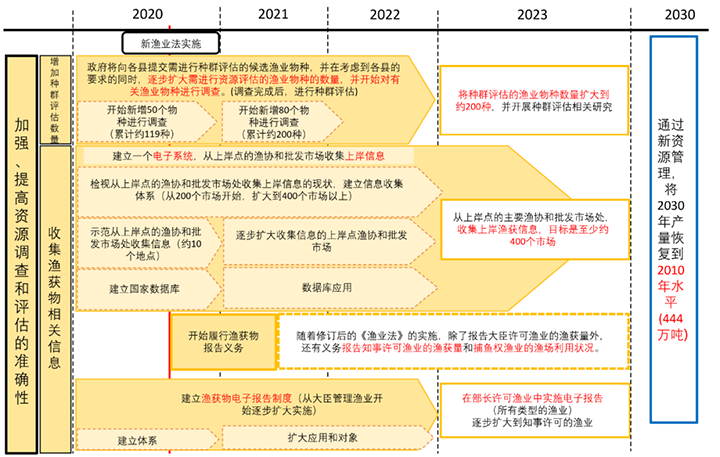 《渔业资源管理路线图》之资源评估与信息收集 @日本水产厅
《渔业资源管理路线图》之资源评估与信息收集 @日本水产厅
11月,日本发布《2021年水产白皮书》,回顾了往年的渔业基本计划,简单介绍了最新的渔业基本计划,分析了新冠疫情对渔业的影响及行业的应对措施。此外,白皮书还总结了2021年渔业发展状况并预测了2022年的情况。2021年日本在推进新资源管理方面取得的进展包括,资源评估的鱼种数量从2020年的119种增至192种,接近2023年底200种的目标;2021年,8个鱼种(占总渔获量60%)开始实施基于最大可持续产出(MSY)的TAC管理;此外,在2021年捕捞季,日本还将个体配额制度引入大中型围网鲭类渔业。
ꔷ 韩国
7月,韩国开始对带鱼、小黄鱼和马鲛鱼实施TAC管理。这使得韩国TAC管理的鱼种数量增至15个,渔业类型增至17个。其中,由中央政府确定可捕量的鱼种有11个,地方政府确定可捕量的鱼种(主要是贝类)为4个。此次扩充将TAC管理的覆盖率扩大到沿海捕捞总量的40%。根据韩国 “渔业创新2030” 改革计划,韩国政府正在推进全面建设基于TAC的资源管理结构,TAC管理率2025年将达到50%,2027年60%,2030年80%。一项为期两年的鳀鱼TAC试点也在7月启动。
11月,韩国国会研究院立法研究室发表了《<沿海渔业结构改善和支持法>下沿海渔船削减项目的立法影响分析》。报告指出,韩国从1994年来开展的削减渔船数量项目并未扭转渔业资源下滑的势头。照此趋势,韩国政府在《第二个沿海渔业结构优化基本计划(2019-2023年)》中设定的目标将很难实现。该计划曾提出,到2022年,通过削减沿海渔船数量推动渔业资源量达到400万吨,沿海渔业产量达到110万吨。报告提出了未来改进的方向,包括彻查减船项目的有效性和方法的适当性,多角度分析资源量和产量下降原因,以及强化“转业上岸”渔民生计稳定措施等。
ꔷ 印尼
3月,《印尼海洋事务与渔业部长2022年第19号关于估算印度尼西亚共和国渔业管理区的鱼类资源潜力、总可捕捞量和鱼类资源利用水平的法令》生效。4月,印尼公布,全国可持续捕捞潜力为每年1200万吨,这是该国首次采用国际标准和科学方法进行估算。目前印尼的年产量约为650万吨。为了增加产业收入和促进可持续发展,印尼海洋事务与渔业部正在推动全国渔业由投入管理向产出管理改革,并计划于2023年开始实施TAC管理政策。限额将分鱼种设定,并划分为商业配额、传统渔民配额和非商业配额(研究、休闲等)。商业捕捞允许外国投资参与。支撑TAC制度的其他法规也在制定中,包括配额分配和定点上岸等监管规定。
 印尼渔业管理区按配额类型的划分 @印尼海洋事务与渔业部
印尼渔业管理区按配额类型的划分 @印尼海洋事务与渔业部
ꔷ 越南
9月,越南政府批准了《2022-2025年防止IUU捕捞规划》。规划要求,到2025年,所有长度在15米以上的渔船在离港前都要接受检查,以确保相关文件和设备都符合规定;所有15米以上的渔船在海上时都必须通过船位监测系统进行监测,并在进港时接受检查;国内捕捞的渔获物在上岸时必须按照规定进行检查和监督;所有在越南港口上岸的外国渔获物都必须按照联合国粮食及农业组织(FAO)2009年的港口国措施协议(PSMA)进行检查和监督。
9月,越南政府批准了《2022-2025年期间并着眼于2030年发展高效和可持续渔业的国家规划》。计划的总目标是实现捕捞能力与可捕资源量平衡的可持续渔业、实现高经济效率、改善作业安全性与渔民生活水平等。计划主要明确了到2025年和2030年的具体目标、主要任务、实施方案和资金安排。例如,到2025年,外海捕捞许可的渔船数量要在2020年的基础上减少10%,所有沿海省市需确定管辖区域内的渔船限额;到2030年,要实现《2021-2030年并着眼于2050年水生资源保护和开发规划》所确定的船队结构、作业类型和渔业总产量。
其他
12月,经济合作与发展组织(OECD)发布《2022年渔业报告》。报告分析和总结了32个国家或地区的渔业种群健康状况、管理方式和政府支持政策。报告指出,尽管各国或地区的渔业管理方式各异,但TAC被认为是确保鱼类种群健康的最重要工具之一。报告对29个国家或地区经济价值最高的107个鱼种共313个种群进行了评估,发现超过3/4的种群都使用了TAC管理,仅次于渔具限制(用于87%的种群)。2020年,由TAC管理的鱼种产量为1260万吨,价值92亿美元,占经济合作与发展组织收集数据的所有鱼种产量的81%和价值的61%。未被TAC覆盖的鱼种以及TAC未设定在可持续水平的鱼种,可能面临不可持续捕捞的风险。报告建议,增加使用TAC等配额机制有助于确保最重要渔业的经济、社会和环境可持续性。
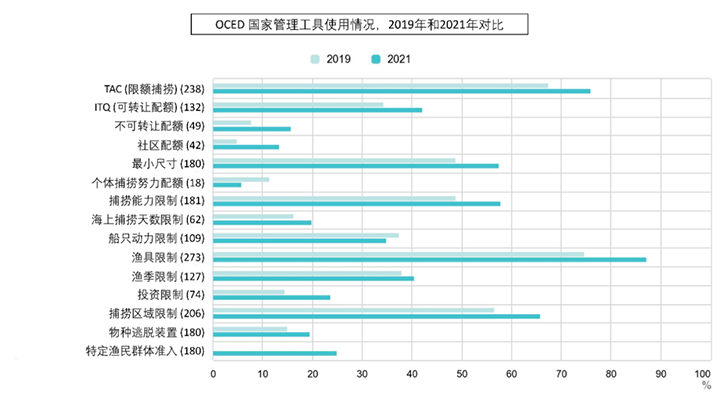 2019和2021年经济合作与发展组织国家渔业管理工具的使用情况 @经济合作与发展组织
2019和2021年经济合作与发展组织国家渔业管理工具的使用情况 @经济合作与发展组织
2022年,联合国粮食及农业组织发布《理解和实施渔获产品证明文件制度(CDS)- 国家主管机构的指南》。作为打击IUU捕捞的工具之一,这个制度通过经主管部门验证的渔获产品证书和贸易文件对渔获物进行从捕捞到上市销售的追踪,确保其来源符合所有适用的法律要求。该指南介绍了相关的法律背景、现行制度的结构以及确定国家关键数据要素的指导建议等,同时强调了需要建立强大的国家级系统以满足该制度相关信息的确认和核验要求。
 渔获产品证明文件制度(CDS)示意图 @联合国粮食及农业组织
渔获产品证明文件制度(CDS)示意图 @联合国粮食及农业组织
①冰岛渔业管理主要采用可转让配额(ITQ)制度,渔船是配额的持有者(holder),每年获得总可捕捞量的特定比例份额。


